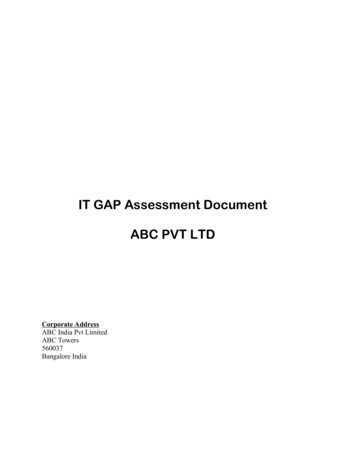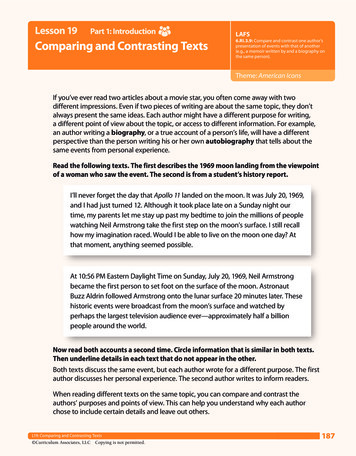
Transcription
Helen Bevan@helenbevan #Quality2019
@helenbevan #Quality2019
How do we both scaleup and scale down?Personalised care(“what matters tome?”) for eachindividual AND at ascale that impacts onhundreds ofthousands of people3
Scaling up and scaling downHow do we improve oursystem across XXX(geographical area) so thatevery one of the X,000citizens who uses ourservices sees and feelsimprovement in their healthand care?@helenbevan #Quality2019
Across the globe, people are questioning theconventional “spread” modelPilot projectRolling out“If we opened our eyes we would see the wonderful irony. Tryingto manage human change through pilot and roll-out has actuallygrown something. A proliferation of project managers”.John Atkinson@helenbevan #Quality2019
Because the reality is often different,ytiralugergniWith alarmehtnistolipgnmany promisitnemevorpmiehealth carfieldnoitatnemelpand imtcapmillarevoehave littl”yldaorberomdwhen appliethlaeH,seugaelloPerla & cAffairs blog,April 2015@helenbevan #Quality2019
The reality of spread A dynamic, reciprocalinteracting, iterative andevolving activity.notlinear and mechanistic developmental,contextualised, adaptive,learning and socialprocess@helenbevan #Quality2019
7 interconnected principles1. Complexity
The key thing to remember aboutspread in health and careIn health and care improvement, we often tryto design complex spread processes as if theywere complicated & it doesn't work. Complexisn't higher-order complicatedness. It is afundamentally different kind of complex-and-complicated-systems/@helenbevan #Quality2019
Seven differences between complicated and complexComplicatedComplexCausalityLinear cause-and-effect pathways allowus to identify individual causes forobserved effectsThere are no clearly distinguishablecause-and-effect pathwaysLinearityEvery output of the system has aproportionate input i.e. Newtonian physicsapply.Outputs are not proportional or linearly related toinputs; small changes in one part of the system cancause sudden/unexpected outputs in other parts ofthe systemWe can decompose the system into itsstructural parts and understand thefunctional relationships between theseparts in a piecemeal way.The structural parts of the system aremultifunctional i.e. the same function can beperformed by different structural partsControllability& solvabilitySystemic contexts and interactions can becontrolled, and the problems they presentcan be diagnosed and permanently solvedThese systems are prone to high levels ofsurprise, uncertainty and interventions causingunexpected changes and even new or worsechallenges.Constraint(openness)Environments are delimited i.e. governingconstraints are in place that allows thesystem to interact only with selected orapproved types of systems.Complex systems are open systems, to theextent that it is often difficult to determine wherethe system ends and another start.KnowabilityThese systems, because they are closed andcan be deconstructed can be fully known ormodelledWe cannot transform complex systems intocomplicated ones by spending more time andresources on collecting more data or developingbetter theoriesCreativity &adaptabilityComplicated systems need an externalforce to act on them in order to introducechangeThese systems are able to observe themselves,learn andSonjaadapt.BlignautThey are@sonjablcreative.Source:Reducibility
7 interconnected principlesComplexitySpread in health and care is a complex activityoccurring across a system Complexity around innovation, the process ofspread, the context of spread Health and care is a complex adaptive system Match complexity of the approach to spreadwith complexity of the situation@helenbevan #Quality2019
Complex systems are driven by the qualityof the interactions between the parts, not thequality of the parts. Working on discrete partsor processes can properly bugger up theperformance at a system level. Never fiddlewith a part unless it also improves the system@ComplexWalesSource of image: Eclipse
7 interconnected principles“Adaptive space”: an interfacebetween innovations and theoperational systemComplexityImprovementLeadership:Innovation &improvementsystem@helenbevan #Quality2019Source: adapted fromMary Uhl-Bien
7 interconnected principles2. Development of innovationInnovation development and spread areinterdependent How an innovation is developed influencesspread Early involvement increases commitment andownership Increased focus on role of adopters inadaptation and spread#nhsspread @ExpoNHS #Expo19NHS
Crossing the chasm!Source of image: @voinonen
NHS Continuing Healthcare (CHC) Collaborative:Model of spread165 local teams, 1,000 participants, 90%of the interaction is virtualThe developmentgroup: testingpioneering new ways toThedeliver CHCThe test and scaleDevelopmentgroup group: testingGroupthe fidelity of new ways10 local CHCTheteams with local Test and Scaleof working in differentpartnersGroupcontextsThe ImprovementCommunityAll local teams withpartners16 localteamsThe improvement community:Engagement of other localteams right from the start, sorelationships are built, all arecontributing, sharing andlearning and the optimalconditions for spread are beingcreated.
NHS Continuing Healthcare StrategicImprovement ProgrammeOutcomes to date (Board report March 2019) Tangible improvements in assessment No change in eligibility rates A cost saving to date of 757million pounds‘The CHC Collaborative has given us a voice forthe first time ever. We have felt listened to andyou have given us a fire in our bellies to make uswant to change and improve the care for ourpatients . Don’t disappear and let the fire go outthis work must not stop.’
7 interconnected principles3. ValueFocus on the value rather than the innovation It’s about what others will value rather thanwhat you want to spread What problem of local priority will it solve? What benefit will it offer?@helenbevan #Quality2019
7 interconnected principles4. The IndividualThe perspective of the individual is pivotal Changing behaviours is hard The more work routines affected, the greaterthe spread challenge Generate energy for change, skills andconfidence by building motivation@helenbevan #Quality2019
7 interconnected principles5. LeadershipFrom aninward to anoutwardmindset
7 interconnected principles6. NetworksNetworks build communities, energising andconnecting individuals Spread will happen more through relationshipsthan any other factor Create a “pull” for innovation by buildingcommunities to energise individuals and maintainmomentum Support networks and encourage connectionswith other networks Support use of network building mechanisms; egplatforms like WhatsApp, Slack, Facebook groupsand other social media@helenbevan #Quality2019
Relational(two way)Synchronous(at the same time)Asynchronous(at different times)Broadcast(one way)
Relational(two way)Microsoft teamsFacebook groupLinked In groupTwitter conversationSmartphone Q&A/polling, eg SlidoConference callTweetchatVideo meetingVirtual hackathonFace to face hackathonFacebook liveIdeas channelYammer or other EnterpriseEmailSocial NetworkInstagramSlack groupBasecamp groupWhatsApp GroupCrowdsourcing platformClinical guidelineDial-in telephone updateSpeech or presentationLive webinarCorporate TwitterAdvertPolicies & proceduresNewsletterYouTubeBroadcast(one way)Asynchronous(at different times)Synchronous(at the same time)Face to face meetingLive virtual learning sessionVirtual community thcarecampaign
Ambulance service improvement project 13 ambulance services across England,Scotland, Wales and Northern Ireland Spreading improvements in staff wellbeing,responding to people who fall, responding topeople in mental health crisis
Relational(two way)Microsoft teamsFacebook groupLinked In groupTwitter conversationSmartphone Q&A/polling, eg SlidoConference callTweetchatVideo meetingVirtual hackathonFace to face hackathonFacebook liveIdeas channelYammer or other EnterpriseEmailSocial NetworkInstagramSlack groupBasecamp groupWhatsApp GroupCrowdsourcing platformClinical guidelineDial-in telephone updateSpeech or presentationLive webinarCorporate TwitterAdvertPolicies & proceduresNewsletterYouTubeBroadcast(one way)Asynchronous(at different times)Synchronous(at the same time)Face to face meetingLive virtual learning sessionVirtual community thcarecampaign
7 interconnected principlesLearningKnowledge flows generate learning to enablespread Collate and share local feedback andevaluation of innovation adoption and impact Share knowledge through networks Build a culture of learning and transparency,sharing and seeking knowledge from others@helenbevan #Quality2019
Sharing knowledge and learning forspread at multiple levelsSocial NetworksSource: Harold Jarche
Everret Roger’s diffusion ofinnovation curve
Everret Roger’s diffusion ofinnovation curveInnovators
Everret Roger’s diffusion ofinnovation curveAdoptersInnovators
The key role of the “convenor” for enabling spread: Acting as interface betweeninnovation and ‘usualbusiness’ Creating an adaptiveenvironment for spread Lessening ambiguity foradopters in complex changesituations Strategically coordinatingspread across a whole system Mobilising networks, crowdsand influencers@helenbevan #Quality2019
Programme manager vs. convenorPROGRAMMEMANAGER Designs a plan Accountability withina governance system Ensures that deliverymilestones are met Deals with risk andensures that barriersare overcomeComplicatedCONVENOR Works with emergence Builds commitment to acollective goal Builds relationships Seeks win/wins Makes sense of thingsfor adopters: the why? Enables spread across awhole systemComplex
A role description for a convenor1.2.3.4.5.6.7.8.Convenor: creating spaces where people can come together to learn andshare and influencing people to take partChoreographer: bringing diverse people together, building bridgesbetween their different worlds and creating the “dance”Co-producer: ensuring that people who use services and staff at thepoint of care are true partners in making and spreading changeConnector: helping people make links with each other, within the systemand beyondCapability-builder: supporting people to use proven methods and toolsfor making and spreading changeClarifier: helping people make sense of the changes from their ownperspective and reducing ambiguityCoach: providing support and mentoring to help guide and steer changeCommunity-builder: building a shared purpose and a sense of “us”Source: adapted by Helen Bevan from the work of John Bessant
Scaling down Find out “what matters tome?” Start from people’s interests,strengths and abilities See people in their widercontext - not just theirhealthcare symptoms Build on assets - don’t justminimise deficits Spread happens one personat a time Cultivate a co-design mindset,not just an expert one@helenbevan #Quality2019Scaling up Start with shared purpose Design for a complexsystem, not a complicatedone Create adaptive spaceswhere people can learnand share Build an outward mindset Involve potential adopteesright from the start Evaluate, reflect and learnas you go
1. What were the main things youlearnt from this session?2. How could this be useful to you?3. What might you do differently asa result?@helenbevan #Quality2019Adapted from Bennet-Levy & Padesky, 201
outward mindset 7 interconnected principles 5. Leadership . Networks build communities, energising and connecting individuals Spread will happen more through relationships than any other factor Create a “pull” for innovat








